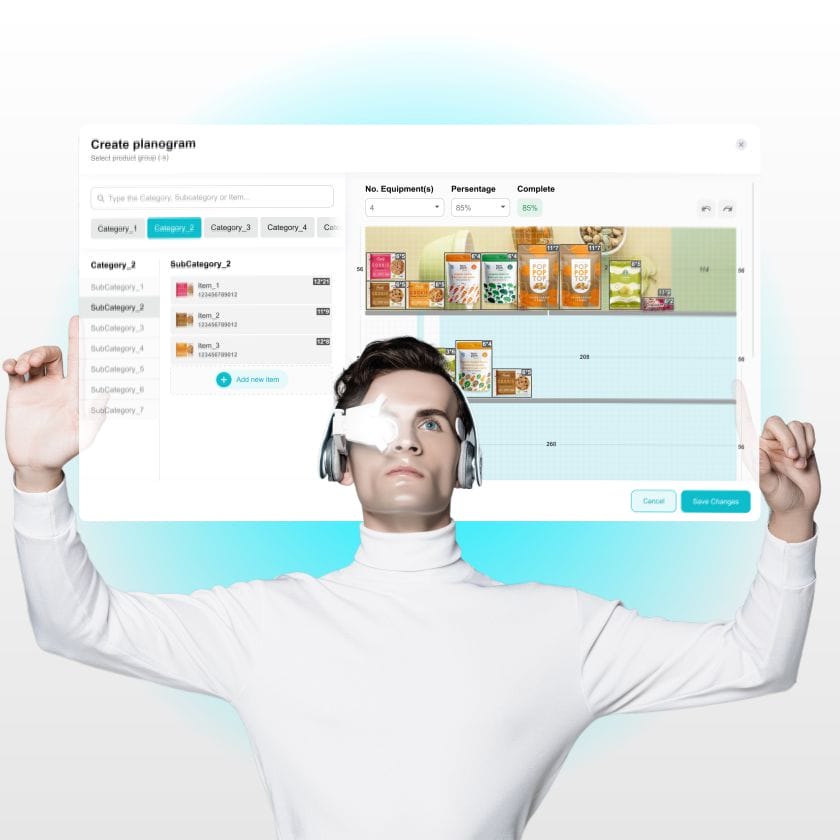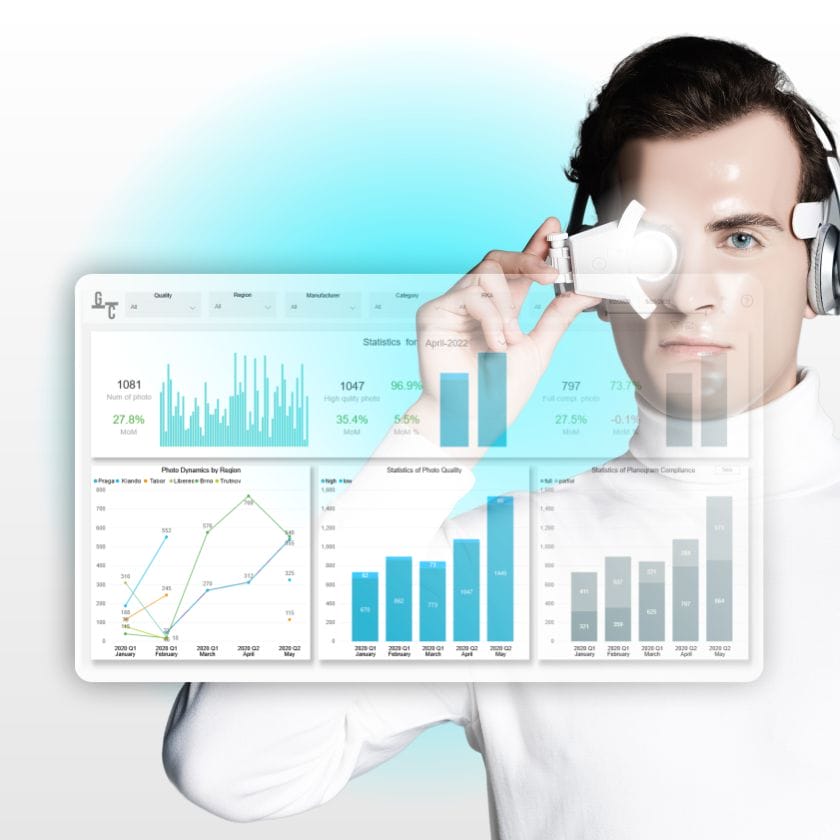Merchandising agencies are increasingly taking interest in technologies that automate their processes and enable them to do more in less time. Today, speed, quantity and quality are the main ingredients for success, and automation allows achieving high performance for each.
In this article, retail automation experts from IBA Group will explore how computer vision can help merchandising agencies optimize their operations, earn customer loyalty and establish long-term partnerships with them.
Table of Сontents
- Operational Aspects of a Merchandising Agency
- Applications of Computer Vision for Agencies
- Replacing an Excel spreadsheet with an electronic planogram with a photo
- Configuring the actual size of SKUs and equipment
- Instant photo processing
- Release of new products in one day
- Real-time analytics
- Getting Started with Goods Checker
- Goods Checker Benefits for a Merchandising Agency
Operational Aspects of a Merchandising Agency

Merchandising agencies conduct audits of outlets instead of the FMCG company that engaged them. Agency employees check layout compliance with the planogram, available stock balance, correct shelf labels and availability of POS materials and then provide analytical reports to their client. Since there are many clients, it is important for the agency to optimize processes and reduce their time and financial costs without compromising quality.
Clients usually have certain requirements for agency merchandisers and for the expected results. Some of them include:
- Regular visits. Clients require agency employees to visit retail outlets at a specified frequency. To do this, they determine a minimum and maximum number of days between visits.
- Reporting. Clients expect a merchandising agency to provide prompt reports. Reports should contain all the necessary information, for example, the number of outlets visited, information about the stock of goods, an assessment of compliance with the merchandising rules at the outlet, etc.
- Observance of the rules of business concept. Clients expect merchandisers to follow certain rules, such as display of goods according to the planogram, placement of shelf labels and POS materials, etc. Their performance is evaluated and used to estimate the final price for merchandising services.
When engaging a merchandising agency, clients presume that its employees know the standards, rules and features of the display of goods. Agency managers and merchandisers must keep up with trends and best practices in their area. In addition, clients expect a merchandising agency to quickly adapt to changes in the market and use dedicated tools that help achieve the best results.
Applications of Computer Vision for Agencies

Industry-specific tools for merchandisers help agencies improve the quality of services, provide their clients with value propositions that are only available with an IT solution, and stand out from the competition. One such tool is Goods Checker.
Goods Checker is a comprehensive computer vision solution to automate and streamline merchandising processes. Goods Checker helps to quickly audit outlets, manage the availability and correct placement of goods on the shelves, and collect and analyze data on the planogram compliance percentage, the number of out-of-stock, etc.
Let’s take a closer look at specific applications of Goods Checker for a merchandising agency.
Replacing an Excel spreadsheet with an electronic planogram with a photo

Planograms are often created with software that was not originally designed for this task, such as Microsoft Excel. Microsoft Excel is rather good for simple planograms. But when there are a lot of goods, this approach becomes inefficient.
Creating, updating and adding new products and images to them is inconvenient and time consuming. Errors appear both when planograms are prepared by managers, and when the layout is checked by merchandisers.
Goods Checker offers a solution to this problem. Goods Checker has Plano Creator electronic planogram maker. In a few minutes, a manager can create a planogram with several hundred items, add product images, or update a document. Electronic planograms make it much easier to check the display during the outlet audit.
Configuring the actual size of SKUs and equipment

Fast moving consumer goods often have different sizes but are placed side by side. If the planogram is created in a regular spreadsheet, then the cells are likely to be the same size. This means that it is difficult for managers and merchandisers to navigate the document. They have to read the description very carefully and peer into the picture in order to understand, for example, the volume of a bottle of water to be placed on a shelf. It is more difficult for agency employees to get an idea of what a shelf should look like.
Plano Creator module allows creating planograms for SKUs of any size, since you can configure the parameters of equipment and shelves. When preparing a planogram, the actual dimensions of each SKU are also visible, and after dragging them onto the equipment, the system automatically calculates the remaining space on the shelf. This approach allows creating individual planograms for each retail chain.
In addition, Goods Checker can process custom equipment, multi-layered layout (for example, cans standing on top of each other) and merge several photos into one for more complete information.
Instant photo processing

The main problem when processing photos from merchandisers is the number of images and lack of time for supervisors. Therefore, most of the images remain unverified. This results in incomplete data and makes it difficult to evaluate merchandiser performance.
Goods Checker uses computer vision to process photos in real time. By applying special algorithms and neural networks, the system recognizes the position and availability of goods on the shelves. Even if there is no Internet connection in the store, the photos are saved on the merchandiser’s phone and, when the connection reestablishes, they are transmitted to the server for processing. Processing of one photo takes less than 30 seconds, and recognition accuracy exceeds 95%.
Release of new products in one day

Merchandising agency clients regularly release new products or redesign existing ones. Therefore, agencies need to be able to adapt planograms quickly. To do this, they need to add new products to the database, manage different packaging designs at the same time and monitor changes in names. All this is time-consuming and the probability of errors is high.
Goods Checker starts handling new products from the day they go on sale. To train Goods Checker to recognize a new product, only one render is required. Based on this render, the Goods Checker team creates “artificial” photos and trains models.
Real-time analytics

Analytics for each client of a merchandising agency can be different, so creating analytical reports is a time-consuming process. Another problem is that when processing only a few percent of photos from merchandisers, the analytics becomes incomplete and biased. Managers have to extrapolate data and write reports based on the results.
Goods Checker collects real-time analytics. Each processed photo immediately gets into the report. Goods Checker provides a wide range of KPIs: sales by stores, products, days, brands, etc. Each report can be saved in CSV format and exported to the client’s BI system. Agency managers send complete and up-to-date analytics to clients, which enhances confidence and improves relationships with the client.
Getting Started with Goods Checker

To get started with Goods Checker, a merchandising agency needs to complete several steps:
Collection of photos. About a hundred product images are required to train computer vision and the Goods Checker model. This may include shelf photos where the same product may appear multiple times, which will be considered separate images. If you do not have enough photos or the product is new, one render will be enough for training.
Photo markup. The Goods Checker neural network needs an instruction where the desired product is located in the photo. The markup takes into account the angle and spatial orientation. This is usually done by the Goods Checker team, but in some cases, clients can do the markup themselves.
Choice of operation mode. Goods Checker consists of several modules: Plano Creator for creating planograms, Shelf Eye for SKU recognition, Check & Go is a mobile application for merchandisers. Each client can choose the modules and functionality they need.
It usually takes several weeks to prepare the system, mark up the photos, and train the models. After that, the agency can quickly start using Goods Checker.
Goods Checker Benefits for a Merchandising Agency

FMCG industry often tries new technologies, as the market is extremely competitive with continuous competition for customers. Technology helps companies better understand people’s needs, provide personalized offers and increase customer loyalty.
Merchandising is part of the promotion strategy for an FMCG company. Therefore, agencies that offer merchandising services also explore IT solutions. The use of computer technology in the outlet audit can speed up this process by 60%.
Goods Checker provides merchandising agencies with a number of benefits, such as helping them identify bottlenecks in processes, increase performance, improve supervision and reporting, add to marketability and earn customer loyalty.




